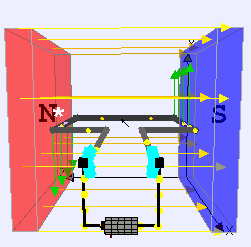A spherical lens is a transparent medium bounded by two surfaces. Atleast one of the two surfaces must be spherical.
If the lens has one spherical surface then other surface will be plane. This results into two types of lenses.
(a) Plano convex lens
(b) Plano concave lens
If both the surfaces of the lens are spherical then following lens are obtained.
(c) Double convex lens ( or simply known as convex lens)
(d) Double concave lens ( or simply known as concave lens)
(e) Convexo concave
(f) Concavo convex
Few terms related to spherical lens
Optical centre (O) : The centre of the lens is known as optical centre.
Principal axis : The line passing through the centre of curvatures of spherical surfaces of lens and the optical centre is called principal axis.
Principal focus of a convex lens
When incident rays parallel to the principal axis falls on a convex lens then after refraction through the lens, all rays meet at a point on the other side of the lens. This point is known as the principal focus of a convex lens.
Since a lens is transparent light can enter the lens from either of the two surfaces. Hence a lens has two foci labeled as F1 and F2.
Focal length (f): The distance between optical centre and focus of a spherical lens is called focal length.
2F1 and 2F2 are the points located at twice the distance of focal length from the optical centre of the lens.
Principal focus of a concave lens
When incident rays parallel to the principal axis falls on a concave lens then after refraction through the lens, all rays diverge and appears to coming from a point on the principal axis. This point is known as the principal focus of a concave lens.
Since a lens is transparent light can enter the lens from either of the two surfaces of the concave lens. Hence a concave lens has two foci labeled as F1 and F2.
Watch a video for formation of image by a convex lens from our YouTube partner 'Learn n Hv Fun'.







